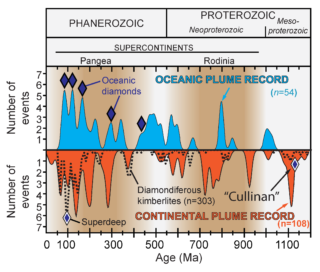Turning trash into diamonds: recycling Mother Nature’s way

The Earth’s deepest diamonds are commonly made up of former living organisms that have effectively been recycled more than 400 kilometres below the surface. EDRG’s latest research, published in Nature’s Scientific Reports, discovered that diamonds found in oceanic rocks and the so-called super-deep continental diamonds share a common origin of recycled organic carbon deep within the Earth’s mantle.
Rare oceanic diamonds are believed to have a mantle transition zone origin like super-deep continental diamonds. However, oceanic diamonds have a homogeneous and organic-like light carbon isotope signature (δ13C -28 to -20‰) instead of the extremely variable organic to lithospheric mantle signature of super-deep continental diamonds (δ13C -25‰ to +3.5‰) (Fig. 1). Here, we show that with rare exceptions, oceanic diamonds and the isotopically lighter cores of super-deep continental diamonds share a common organic δ13C composition reflecting carbon brought down to the transition zone by subduction, whereas the rims of such super-deep continental diamonds have the same δ13C as peridotitic diamonds from the lithospheric mantle. Like lithospheric continental diamonds, almost all the known occurrences of oceanic diamonds are linked to plume-induced large igneous provinces or ocean islands, suggesting a common connection to mantle plumes (Fig. 2). We argue that mantle plumes bring the transition zone diamonds to shallower levels, where only those emplaced at the base of the continental lithosphere might grow rims with lithospheric mantle carbon isotope signatures (Fig. 3).

Lead author Dr Luc Doucet, from Curtin’s Earth Dynamics Research Group within the School of Earth and Planetary Sciences, said the findings offered a fascinating insight into the world’s most expensive gemstones.
“Bringing new meaning to the old trash to treasure adage, this research discovered that the Earth’s engine actually turns organic carbon into diamonds many hundreds of kilometres below the surface,” Dr Doucet said.
“Ballooning rocks from the Earth’s deeper mantle, called mantle plumes, then carry the diamonds back up to the Earth’s surface via volcanic eruptions for humans to enjoy as sought-after gemstones.
“While recycling is becoming a modern-day necessity for our sustainable survival, we were particularly surprised to learn, through this research, that Mother Nature has been showing us how to recycle with style for billions of years.”

The three main types of natural diamonds include oceanic, super-deep continental and lithospheric diamonds, formed at different levels of the mantle with a varying mixture of organic and inorganic carbon.
Co-lead author John Curtin Distinguished Professor Zheng-Xiang Li, the Head of the Earth Dynamics Research Group, said the research provided a model that explains the formation and locations of all three major types of diamonds.

“This is the first time that all three major types of diamonds have been linked to mantle plumes, ballooning hot rocks driven by plate tectonics and the supercontinent cycle from deeper Earth,” Professor Li said.
“This research not only helps to understand Earth’s carbon cycle, but also has the potential to unlock more secrets of the Earth’s dynamic history through tracking the past locations of mantle plumes and superplumes. This can be achieved by mapping out the distribution of both continental and oceanic diamonds.”
However, Professor Li said it remained a mystery as to why diamonds formed in the so-called “mantle transition zone” 400 to 600 kilometres deep utilised recycled organic carbon only.
“This might have something to do with the physical-chemical environment there”, Professor Li said. “It is not uncommon for a new scientific discovery to raise more questions that require further investigation.”.
Contact person: Dr Luc Doucet, Earth Dynamics Research Group, Curtin University.
Relevant publication:
Doucet, L.S., Li, Z.X., Gamal El Dien, H., 2021. Oceanic and super-deep continental diamonds share a transition zone origin and mantle plume transportation. Scientific Reports, In Press. https://doi.org/10.1038/s41598-021-96286-8
Read the Curtin University Media Release:
Related Media Articles:
Cosmos; ABC News; Australian Mining; Science Alert; Mirage News;
